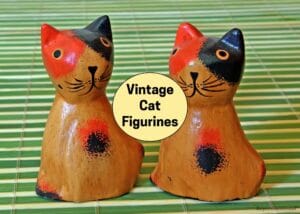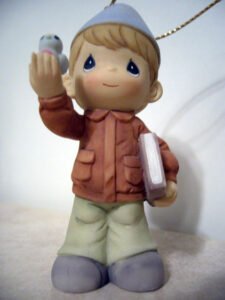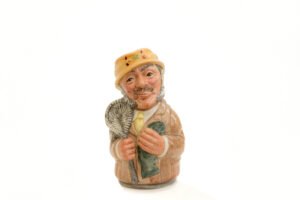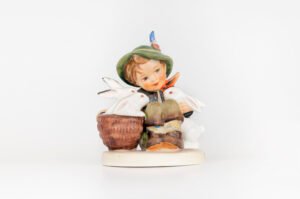Cute and colorful, vintage cat figurines may look like ordinary decor elements! But you’ll start seeing them differently when I tell you these adorable pieces can actually be worth up to $5,000!
Can’t believe it? Well, scroll down this guide where I’ll show you real examples of rare cat figurines that have actually sold for insane prices and tell you why exactly!
Why Cat Figurines Make Great Collectibles?
People created cat figurines as far back as the 1800s. Cats were seen differently by different societies: good fortune in Japan and friendship in Europe. Ancient potters and glassmakers turned these beliefs into gorgeous pieces that served as decoration.
Apart from that, the vintage and antique pieces are in greater demand with collectors and cat enthusiasts for their exceptional craftsmanship, unlike the contemporary plastic figures. I mean, who would not want the original Japanese Lucky Cat over the plastic one, right?
Let us take a look at some of the most valuable and collectible antique vintage cat figurines that are not just decor pieces, but real treasures worth hundreds to a few thousand dollars!
16 Collectible Vintage Cat Figurines Worth Money!
1. Bing and Grondahl Big Cat Figurine
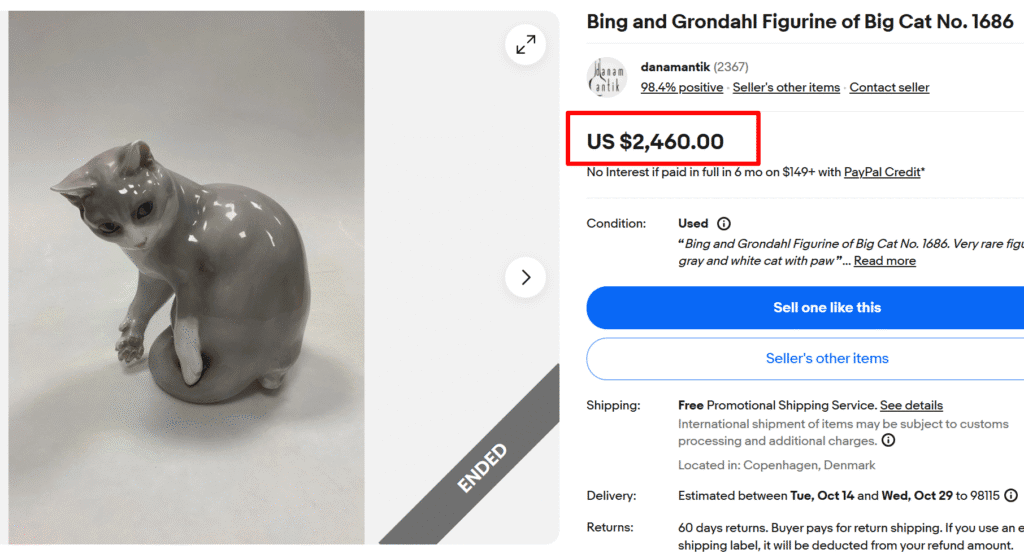
Bing and Grondahl is one of the finest Danish porcelain potters. Their cats have this soft, dreamy quality and often appear in natural, lifelike poses you can’t miss. This is a gray and white big “tuxedo” cat number 1686, a rare retired figurine that can sell for around $2,500 in excellent condition.
Generally, B&G cat figurines range from $40 to more than $4,000, depending on the condition and scarcity. B&G porcelain is fragile, and any breakage destroys the value B&G porcelain is delicate, and any damage kills the value. The glaze should be smooth and even, not cloudy or worn. Also, the three-tower mark on the bottom tells you it’s genuine B&G.
2. Lladro Catrina Cat Figurine
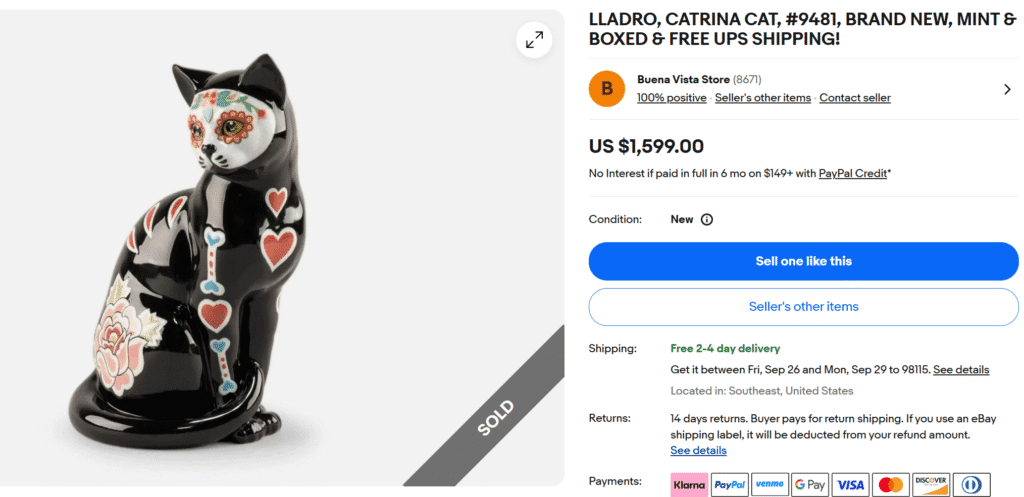
Lladro took the Mexican Day of the Dead imagery and turned it into a stunning black cat with bold and colorful decorations. Designed by José Santaeulalia and Raul Rubio, the Catrina Cat shows hand-painted motifs, like hearts, roses, and other floral motifs. A truly unique piece, this figurine can sell for $500 to over $2,000 in mint condition.
3. Japanese Maneki Neko Lucky Cat Figurines
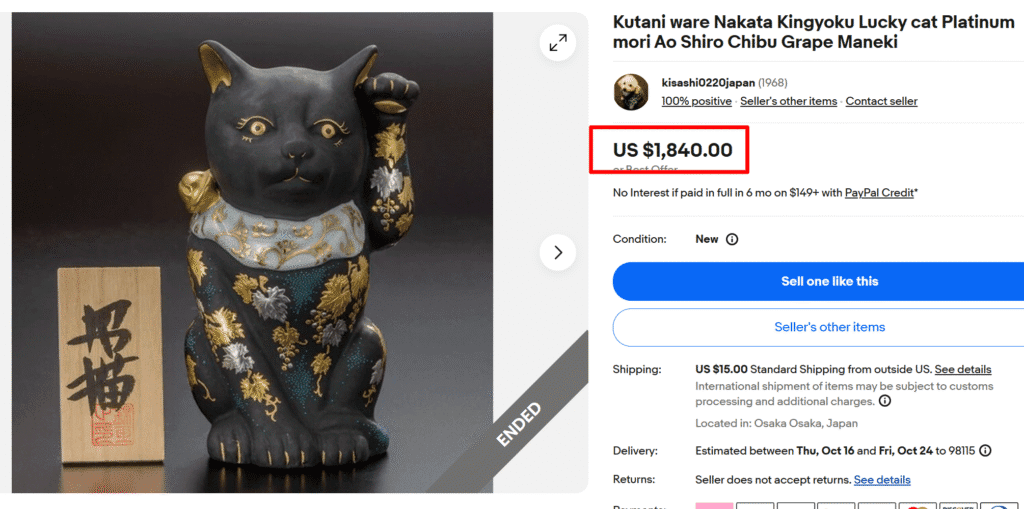
This is a stunning example of the Japanese Maneki Neko, or “Lucky Cats,” the most desirable ones for their cultural significance. These cats have been bringing good luck since the 1600s; right paw up means money’s coming. Left paw up brings customers.
Colors matter too. White for general luck, black to ward off evil, and gold for wealth.
The old Maneki Neko figurines from the Meiji period (1868-1912) are museum pieces now. Even decent vintage examples of porcelain and ceramics from the mid-1900s can sell for hundreds. But modern plastic ones aren’t worth much.
Collector’s Tip: The old Maneki Neko figurines feel heavier, have better painting, and show their age with slight crazing, worn gold details, that patina you can’t fake.
4. Fenton Slag Glass Alley Cat Figurine
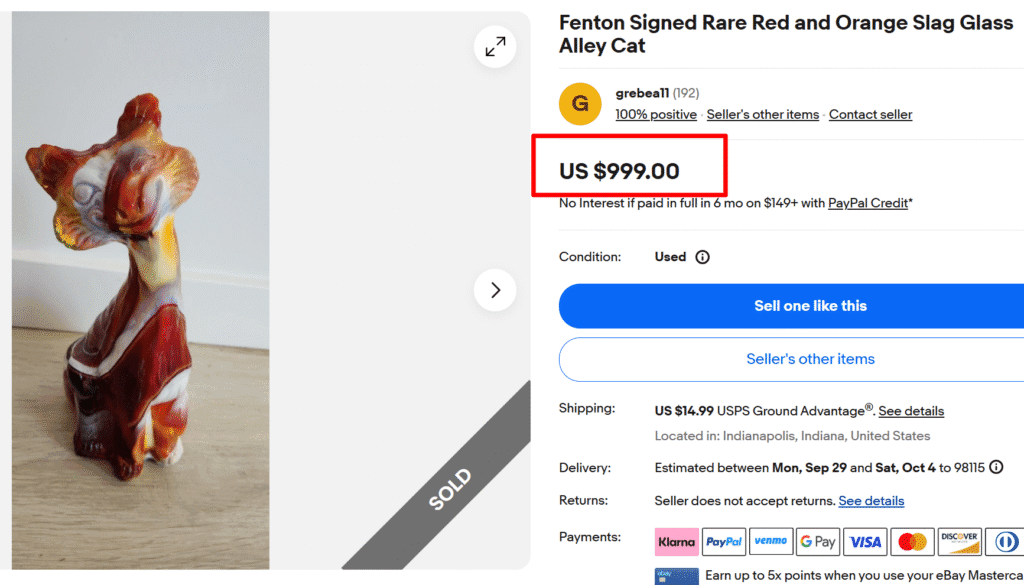
Fenton’s “Alley Cat” figurine is a favorite among collectors and highly valuable, especially those made from slag glass (a glass mixed with a cloudy, marble-like effect, in bold colors).
A rare color combination, especially in excellent condition, can sell for a few hundred to a thousand dollars ($400 to $1,500), like this iconic bright orange, yellow, and red piece. You’ll typically see the Fenton logo on the base.
5. Meissen Porcelain Cat Figurines
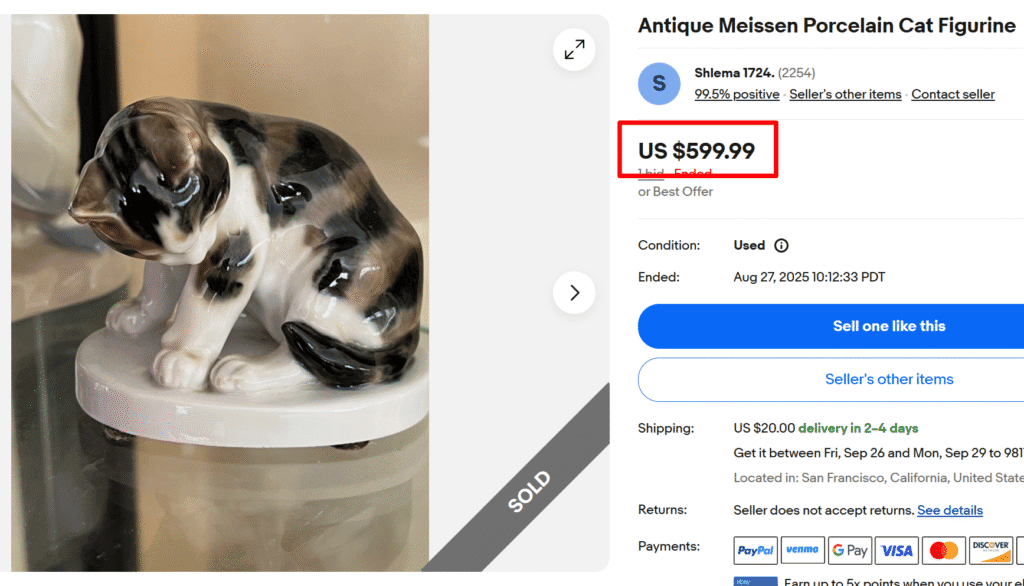
German Meissen made some of the best porcelain worldwide, and their cat figurines are not an exception. The most valuable examples are the 19th and early 20th-century ones, with fabulous work of detail, such as realistic fur texture, natural attitudes, and life-like hand-painted details.
Make sure to check the bottom for crossed swords, Meissen’s trademark since 1720. Without this mark, you don’t have authentic Meissen. Well-preserved Meissen cat figurines regularly sell from $100 to as much as $5,000.
6. Wemyss Ware Cat Figurine (Griselda Hill Pottery)
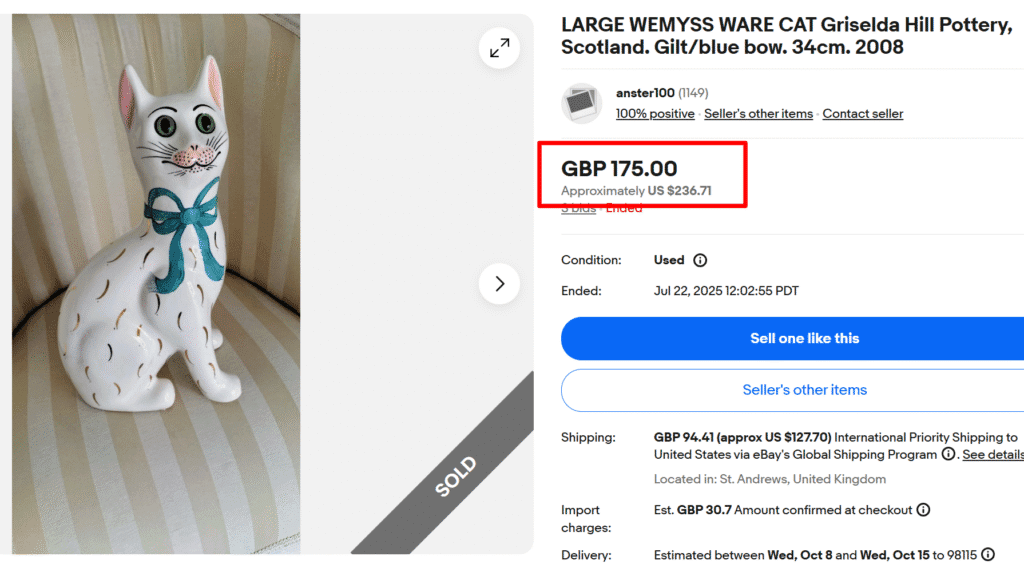
Wemyss Ware is a Scottish line of pottery from the 1880s. Original Wemyss Ware cat figurines were known for their hand-painted floral details, glass eyes, and a delightful, happy look. These were “happy cats!”
This retro example is from Griselda Hill Pottery, which brought back the Wemyss ware style in 1985. Their cats are beautiful, but not as desirable and valuable as the original Wemyss cats. Still, a single piece without damage can go for $80 to $400 or more.
7. Austrian Vienna Bronze Cat Figurine By Fritz Bermann
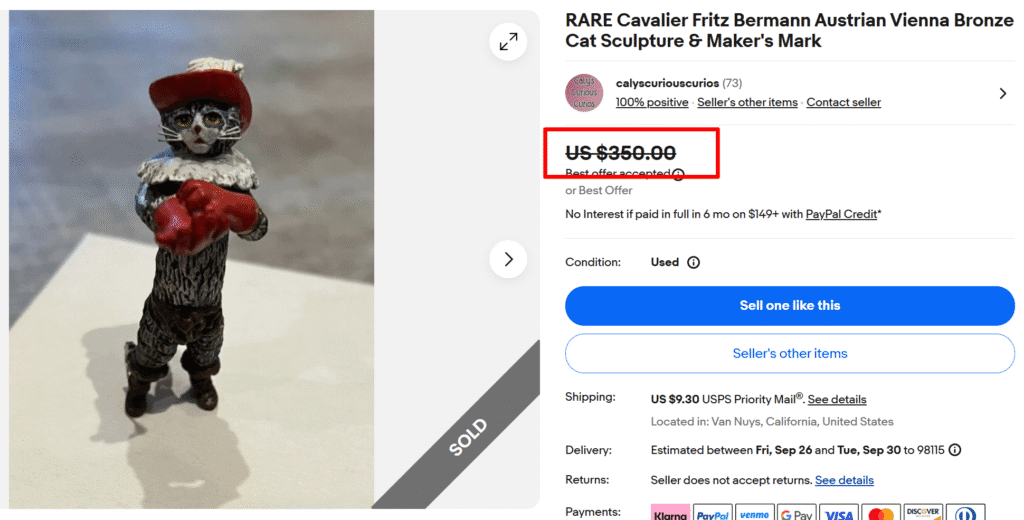
This is an example of those popular, tiny, highly detailed bronze figurines produced in Austria. Coming from the studio of Fritz Bermann, a master of this style. These vintage cat figurines can be worth hundreds of dollars.
You can spot these by their cold-painted surface, meaning the paint was applied after the bronze was cast. Look for the unique and whimsical scenes of cats in various poses and characters, like this one with a hat and gloves.
8. Staffordshire Free Leg Standing Cat Figurines
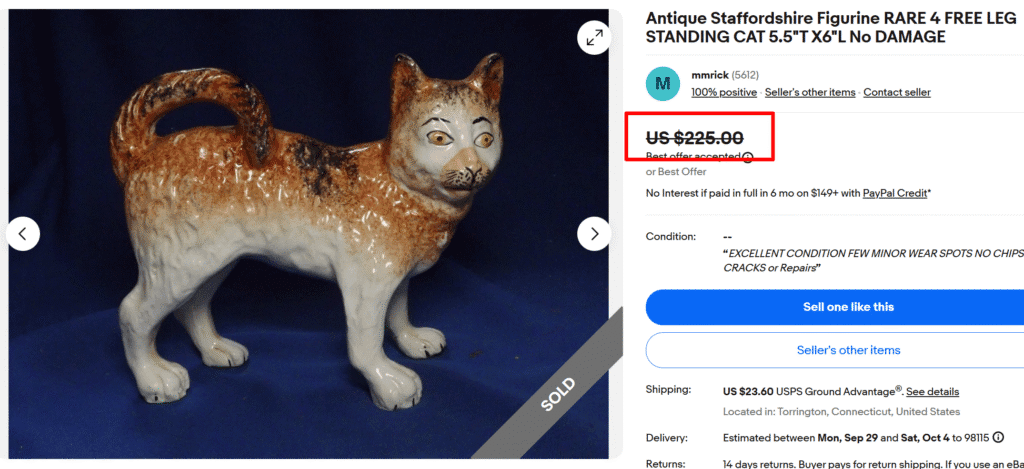
Staffordshire cats mostly came in pairs to be sat on a mantle or a hearth. They’re a classic of the Victorian era. But there’s a much rarer version of these; the “free leg” cats. Instead of just sitting there, these cats have a more playful, dynamic pose with front legs slightly raised.
Standing Staffordshire cats are rare and valuable because they were made in much smaller numbers than the seated cats. An authentic pair of these cats can be worth over $1,000, =-while single ones sell for $150 to $500!
Tip: It’s not always easy to find a genuine Staffordshire cat. So, search for age signs, such as crazing in the glaze and uneven, hand-painted details.
9. Beswick Siamese Ceramic Cat Figurines
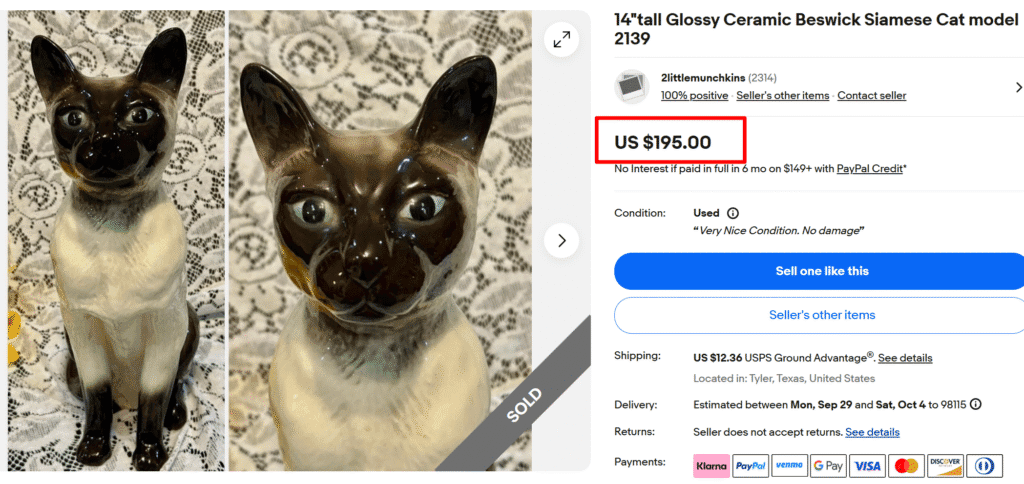
The British ceramics firm Beswick is renowned for its realistic animal shapes, and their Siamese cat figures are among the most sought-after and valuable. What makes them valuable are specific model numbers and color points, like this one is number 2139.
“Beswick model 1898” and “Beswick model 1559” are other most sought-after models that can be worth a lot! Look for a consistent, dark brown “seal point” coloring on the ears, face, and paws, and the impressed “Beswick England” mark on the base to spot these.
10. Hagen Renaker Miniature Cat Figurines
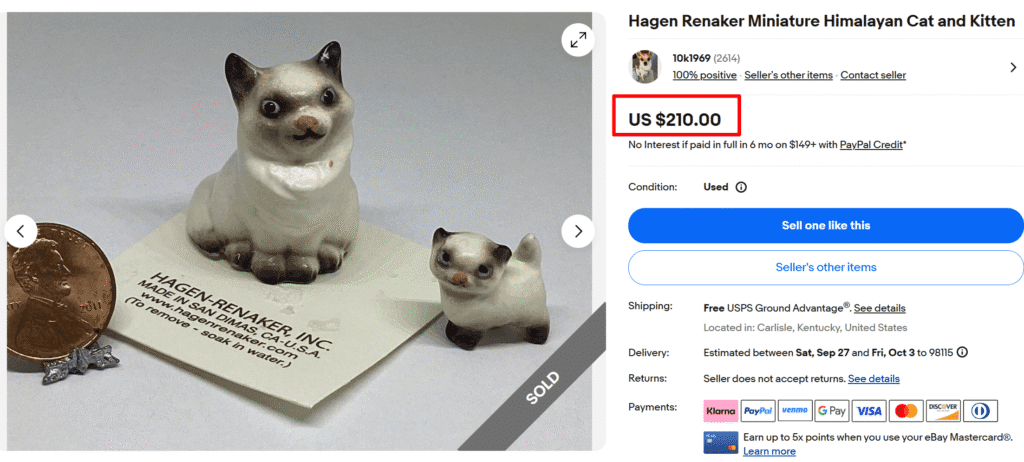
Hagen-Renaker figurines are tiny, hand-painted ceramic miniatures. Their cats come in dozens of breeds and poses, all perfectly detailed despite being tiny. While most are moderately priced, some retired cat models can be highly sought after and worth hundreds.
“Persian Cat with ball” or the “Fuzzy Tuffy Cat” are good examples. These mini cat figurines often have a small “H-R” mark that proves their originality. Some models also come with a certificate or tag, like in this miniature Himalayan cat & kitten set.
11. Royal Doulton Porcelain Cat Figurines
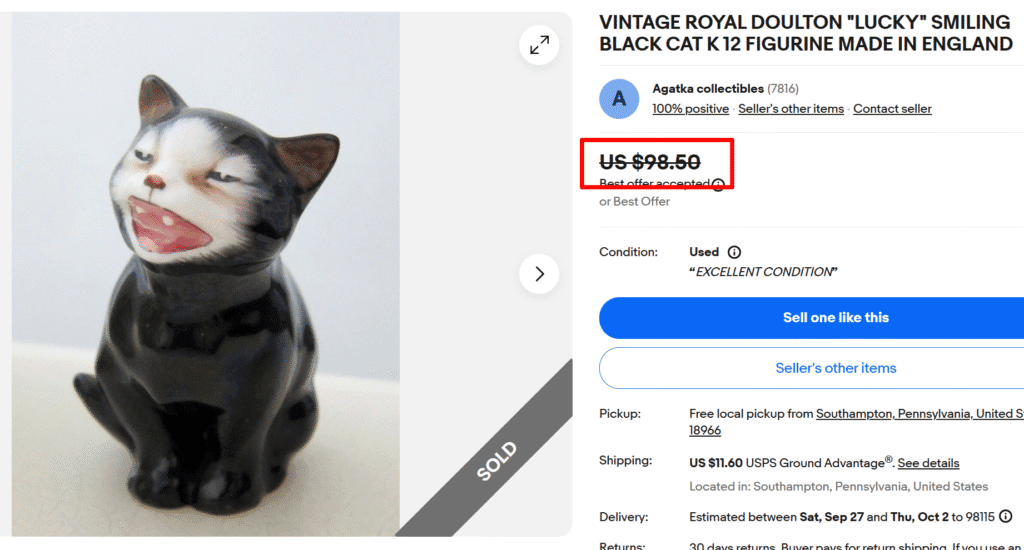
You’ll think character jugs immediately you hear Royal Doulton, but their cat statues are just as much sought after. They are renowned for their refined look and stunning glaze.
Pieces designed by famous designers, such as Leslie Harradine, and having their unique signatures, are the most precious. Look for an item from the early 1900s with the traditional Royal Doulton mark on the underside; those can be quite worth money nowadays.
12. Bitossi (Italy) Midcentury Ceramic Cats
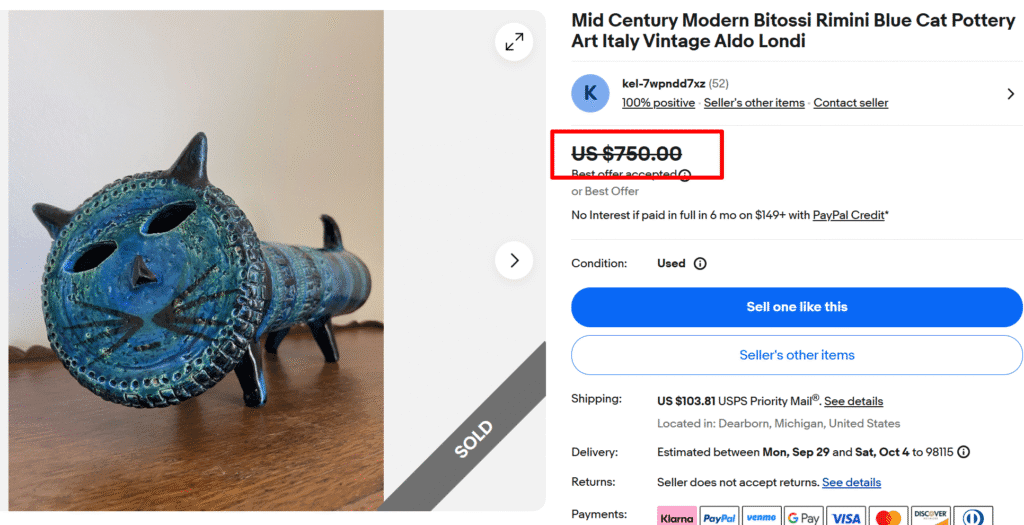
Bitossi is an Italian pottery company that is a favorite among mid-century modern collectors. Their ceramic cats, designed by the popular artist Aldo Londi, are known for their bold, textured designs and vibrant glazes, especially the famous Rimini Blu color.
These aren’t like the typical cat figures; you’ll see weird shapes and forms that sometimes don’t even look like cats. But this distinctive style and the name behind the design are what make them valuable.
You may sometimes find model numbers and signs on the bottom.
13. Japanese Imari or Kutani Porcelain Cats
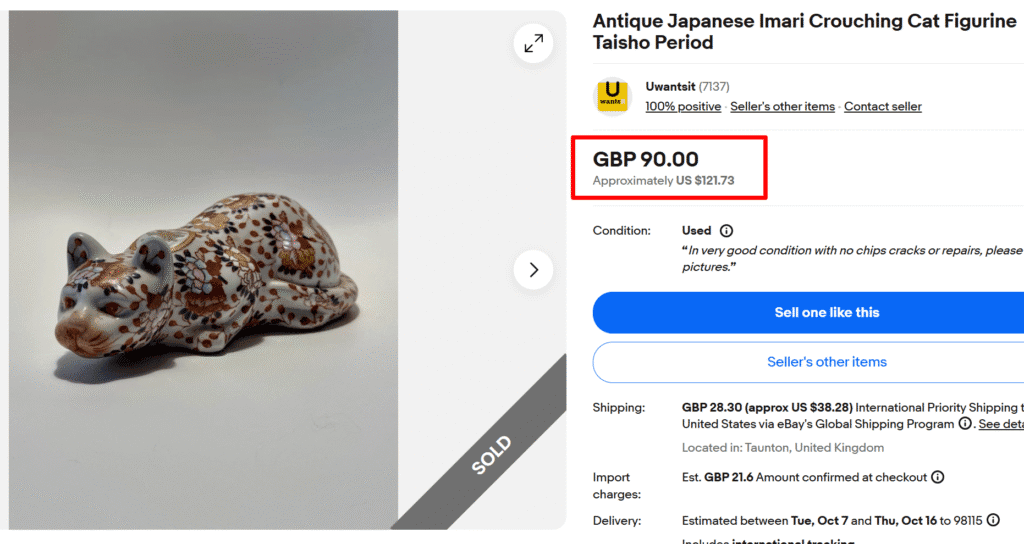
Antique Japanese cat figurines are distinguished by their richly decorated and intricate hand-painted designs, like this crouching cat figurine from the Taisho period.
These come in two styles: Imari, known for its vibrant palette of blues, reds, and golds, and Kutani, which features a broader range of bold colors.
Both Imari and Kutani cats are highly sought-after by collectors for their fine artistry. Most pieces bear a Japanese mark on the base, too. A large, beautifully painted Japanese porcelain cat figure can sell for hundreds or even thousands of dollars.
14. Cartier Sterling Silver Cat Figurines
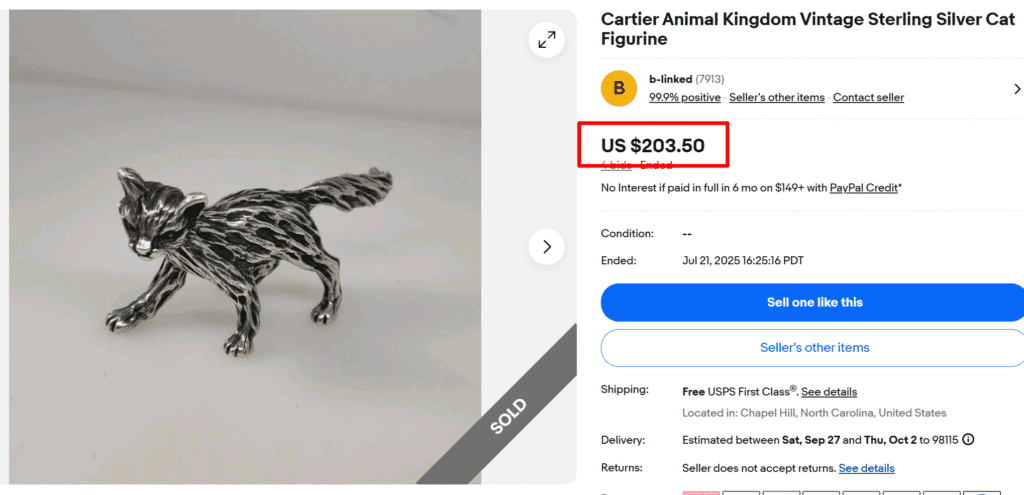
Cartier is world-renowned for their fashion accessories and jewelry, but it has also made figurines. This is a Sterling silver cat figurine from Cartier’s “Animal Kingdom” line, which includes other silver figurines, like a giraffe, a lion, and others.
Don’t forget to check the “Cartier” and the “STERLING” mark on the bottom, since there can be reproductions made of base metals, too. While this example sold for just over $200, the value can go as high as a few thousand in auctions.
15. Fenton Glass Spring Blossom Jadeite Cat Figurine
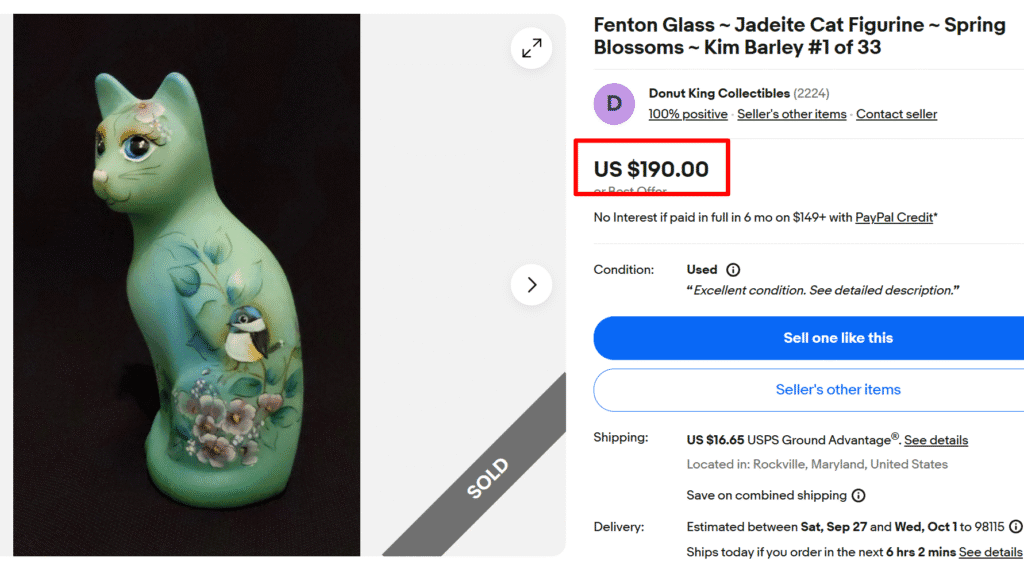
Fenton’s Alley Cat figurines come in a wide variety of colors, but the “Spring Blossom Jadeite” version is one of the most sought-after, being a limited edition with only 33 pieces made by their skilled artist, Kim Barley!
It is a distinctive style with opaque green color, with a delicate floral pattern molded into the glass, produced for a short time, making it rare.
These pieces are generally marked with the Fenton logo on the bottom or the lower side and an artist signature + model number!
16. Antique Heyde Nodder Cat with Cigar
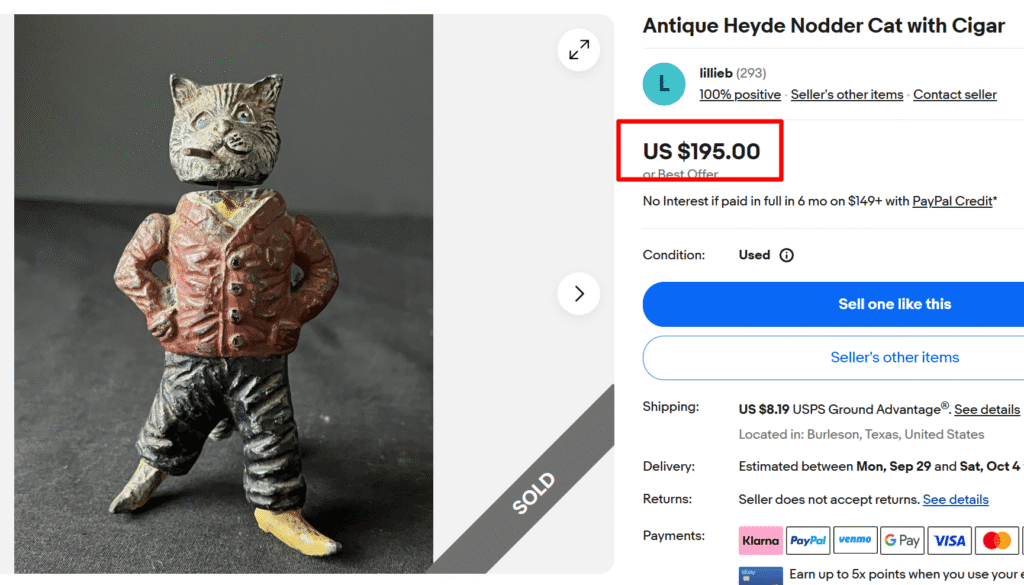
This is a rare cat “nodder,” a figurine with a weighted head that moves when the figure is touched. Heyde, a German toy company, made a series of these in the late 19th and early 20th centuries, which became quite popular.
The cat with a cigar piece is a particularly rare and whimsical model to look for! You can spot this by the outfit: a red jacket and black pants. A piece with intact painted details and the working “nodder” head can be worth $100 to $500+!
What Makes an Old Cat Figure Valuable?
When you’re browsing through antique shops or estate sales looking for cat figures, it’s difficult to decide if something’s worth buying. Here are some factors you need to check:
- Rarity: This is the most important factor. Find out if the figurine was a limited edition or if a specific color or model was only made for a short time! The less common it is, the more valuable it’ll become.
- Markings: Certain makers have high reputations and command higher prices, like Meissen, Wemyss, Royal Doulton, and Lladro. But you need to verify authenticity! That’s why pieces maker’s mark or signature fetch more.
- Condition: Assess the condition rightly. A tiny chip on the ear, a hairline crack, fading, wear spots, and touch-up work all reduce value. Also, check carefully for repairs; sometimes previous owners tried to fix damage with glue or paint that doesn’t quite match. Original paint and glaze should also be intact and vibrant.
- Materials: Figures made from high-quality materials, such as fine porcelain, are worth more than common ceramic pieces.
- Provenance: If you can trace where a cat figure came from, it adds value. An estate sale catalog that shows the piece belonged to a known collector, or documentation proving it came from a famous collection, can increase what someone will pay.
Note: This article is intended for informational, educational, and entertainment purposes only. Some images are illustrative and may not represent actual brands, products, or related entities. All trademarks, product names, brand logos, packaging, and other intellectual property referenced remain the exclusive property of their respective owners. Any brand mentions or references are provided solely for descriptive and educational context and do not imply any formal or commercial association.

